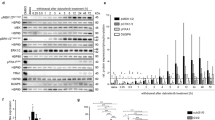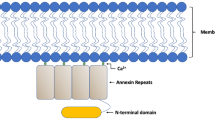Abstract
Local inflammation-induced extracellular matrix structural changes are a prerequisite to neoplastic invasion by pediatric intracranial tumors. Accordingly, increased expression of matrix metalloproteinases MMP-2 and MMP-9, two inflammation-induced matrix metalloproteinases (MMPs), may further aid the transformed cells either to infiltrate adjacent tissues or to enter the peripheral circulation. In the context of neuroinflammation, MMP-9 has been linked to processes such as blood–brain barrier opening and invasion of neural tissue by blood-derived immune cells. Given its reported anti-inflammatory and anticancer properties, we investigated the in vitro pharmacological effects of lupeol, a diet-derived triterpenoid, on MMP-9 and cyclooxygenase (COX)-2 expressions in a pediatric medulloblastoma DAOY cell line model. Lupeol was unable to inhibit the increased MMP-9 and COX-2 expression in phorbol 12-myristate 13-acetate (PMA)-treated cells, but was rather found to synergize with PMA to induce both biomarkers’ expression. A contribution of the membrane type-1 (MT1)-MMP was also revealed, since lupeol/PMA treatments triggered proMMP-2 activation, and that MT1-MMP gene silencing reversed the combined effects of lupeol/PMA on both MMP-9 and COX-2. The mRNA stabilizing factor HuR was also found increased in the combined lupeol/PMA treatment, suggesting stabilization processes of the MMP-9 and COX-2 transcripts. We postulate that lupeol’s anti-inflammatory properties may exert better pharmacological action within low MT1-MMP expressing tumors. Furthermore, these evidences add up to the new pleiotropic molecular mechanisms of action of MT1-MMP, and prompt for evaluating the future in vitro pharmacological properties of lupeol under pro-inflammatory experimental set-up.





Similar content being viewed by others
Abbreviations
- COX:
-
Cyclooxygenase
- IL:
-
Interleukin
- MMP:
-
Matrix metalloproteinase
- MT1-MMP:
-
Membrane type-1 MMP
- NF-κB:
-
Nuclear factor kappa B
- PMA:
-
Phorbol 12-myristate 13-acetate
- PGE:
-
Prostaglandin E
References
Alfranca A, López-Oliva JM, Genís L et al (2008) PGE2 induces angiogenesis via MT1-MMP-mediated activation of the TGFbeta/Alk5 signaling pathway. Blood 112:1120–1128
Amalinei C, Caruntu ID, Giusca SE et al (2010) Matrix metalloproteinases involvement in pathologic conditions. Rom J Morphol Embryol 51:215–228
Annabi B, Lee YT, Martel C et al (2003) Radiation induced-tubulogenesis in endothelial cells is antagonized by the antiangiogenic properties of green tea polyphenol (-) epigallocatechin-3-gallate. Cancer Biol Ther 2:642–649
Annabi B, Bouzeghrane M, Moumdjian R et al (2005) Probing the infiltrating character of brain tumors: inhibition of RhoA/ROK-mediated CD44 cell surface shedding from glioma cells by the green tea catechin EGCg. J Neurochem 94:906–916
Annabi B, Rojas-Sutterlin S, Laflamme C et al (2008a) Tumor environment dictates medulloblastoma cancer stem cell expression and invasive phenotype. Mol Cancer Res 6:907–916
Annabi B, Rojas-Sutterlin S, Laroche (2008b) The diet-derived sulforaphane inhibits matrix metalloproteinase-9-activated human brain microvascular endothelial cell migration and tubulogenesis. Mol Nutr Food Res 52:692–700
Annabi B, Lachambre MP, Plouffe K et al (2009a) Modulation of invasive properties of CD133+ glioblastoma stem cells: a role for MT1-MMP in bioactive lysophospholipid signaling. Mol Carcinog 48:910–919
Annabi B, Laflamme C, Sina A et al (2009b) A MT1-MMP/NF-kappaB signaling axis as a checkpoint controller of COX-2 expression in CD133+U87 glioblastoma cells. J Neuroinflammation 6:8
Annabi B, Lachambre MP, Plouffe K et al (2009c) Propranolol adrenergic blockade inhibits human brain endothelial cells tubulogenesis and matrix metalloproteinase-9 secretion. Pharmacol Res 60:438–445
Annabi B, Vaillancourt-Jean E, Weil AG et al (2010) Pharmacological targeting of beta-adrenergic receptor functions abrogates NF-kappaB signaling and MMP-9 secretion in medulloblastoma cells. Onco Targets Ther 3:219–226
Bao S, Wu Q, McLendon RE et al (2006) Glioma stem cells promote radioresistance by preferential activation of the DNA damage response. Nature 444:756–760
Béliveau R, Gingras D (2007) Role of nutrition in preventing cancer. Can Fam Phys 53:1905–1911
Belkaid A, Fortier S, Cao J et al (2007) Necrosis induction in glioblastoma cells reveals a new “bioswitch” function for the MT1-MMP/G6PT signaling axis in proMMP-2 activation versus cell death decision. Neoplasia 9:332–340
Bu X, Zhao C, Dai X (2011) Involvement of COX-2/PGE(2) pathway in the upregulation of MMP-9 expression in pancreatic cancer. Gastroenterol Res Pract 2011:214269
Chambers AF, Matrisian LM (1997) Changing views of the role of matrix metalloproteinases in metastasis. J Natl Cancer Inst 89:1260–1270
Currie JC, Fortier S, Sina A et al (2007) MT1-MMP down-regulates the glucose 6-phosphate transporter expression in marrow stromal cells: a molecular link between pro-MMP-2 activation, chemotaxis, and cell survival. J Biol Chem 282:8142–8149
Fan XC, Steitz JA (1998) Overexpression of HuR, a nuclear-cytoplasmic shuttling protein, increases the in vivo stability of ARE-containing mRNAs. EMBO J 17:3448–3460
Fernandez MA, de lasHeras B, Garcia MD et al (2001) A new insights into the mechanism of action of the anti-inflammatory triterpene lupeol. J Pharm Pharmacol 53:1533–1539
Fortier S, Labelle D, Sina A et al (2008a) Silencing of the MT1-MMP/G6PT axis suppresses calcium mobilization by sphingosine-1-phosphate in glioblastoma cells. FEBS Lett 582:799–804
Fortier S, Touaibia M, Lord-Dufour S et al (2008b) Tetra- and hexavalent mannosides inhibit the pro-apoptotic, antiproliferative and cell surface clustering effects of concanavalin-A: impact on MT1-MMP functions in marrow-derived mesenchymal stromal cells. Glycobiology 18:195–204
Geetha T, Varalakshmi P (1999) Anticomplement activity of triterpenes from Crataeva nurvala stem bark in adjuvant arthritis in rats. Gen Pharmacol 32:495–497
Han YP, Tuan TL, Wu H et al (2001) TNF-alpha stimulates activation of pro-MMP2 in human skin through NF-(kappa)B mediated induction of MT1-MMP. J Cell Sci 114:131–139
Kang MJ, Ryu BK, Lee MG et al (2008) NF-kappaB activates transcription of the RNA-binding factor HuR, via PI3K-AKT signaling, to promote gastric tumorigenesis. Gastroenterology 135:2030–2042
Kanu OO, Mehta A, Di C et al (2009) Glioblastoma multiforme: a review of therapeutic targets. Expert Opin Ther Targets 13:701–718
Mazloom A, Zangeneh AH, Paulino AC (2010) Prognostic factors after extraneural metastasis of medulloblastoma. Int J Radiat Oncol Biol Phys 78:72–78
Moreau RA, Whitaker BD, Hicks KB (2002) Phytosterols, phytostanols, and their conjugates in foods: structural diversity, quantitative analysis, and health-promoting uses. Prog Lipid Res 41:457–500
Ou Y, Li W, Li X et al (2011) Sinomenine reduces invasion and migration ability in fibroblast-like synoviocytes cells co-cultured with activated human monocytic THP-1 cells by inhibiting the expression of MMP-2, MMP-9, CD147. Rheumatol Int 31:1479–1485
Packer RJ (2007) Craniospinal radiation therapy followed by adjuvant chemotherapy for newly diagnosed average-risk medulloblastoma. Curr Neurol Neurosci Rep 7:130–132
Papi Reddy K, Singh AB, Puri A, Srivastava AK, Narender T (2009) Synthesis of novel triterpenoid (lupeol) derivatives and their in vivo antihyperglycemic and antidyslipidemic activity. Bioorg Med Chem Lett 19:4463–4466
Proulx-Bonneau S, Pratt J, Annabi B (2011) A role for MT1-MMP as a cell death sensor/effector through the regulation of endoplasmic reticulum stress in U87 glioblastoma cells. J Neurooncol 104:33–43
Saleem M (2009) Lupeol, a novel anti-inflammatory and anti-cancer dietary triterpene. Cancer Lett 285:109–115
Saleem M, Afaq F, Adhami VM et al (2004) Lupeol modulates NF-kappaB and PI3K/Akt pathways and inhibits skin cancer in CD-1 mice. Oncogene 23:5203–5214
Saleem M, Kaur S, Kweon MH et al (2005) Lupeol, a fruit and vegetable based triterpene, induces apoptotic death of human pancreatic adenocarcinoma cells via inhibition of Ras signaling pathway. Carcinogenesis 26:1956–1964
Sato H, Takino T, Miyamori H (2005) Roles of membrane-type matrix metalloproteinase-1 in tumor invasion and metastasis. Cancer Sci 96:212–217
Siddique HR, Saleem M (2011) Beneficial health effects of lupeol triterpene: a review of preclinical studies. Life Sci 88:285–293
Sina A, Proulx-Bonneau S, Roy A et al (2010) The lectin concanavalin-A signals MT1-MMP catalytic independent induction of COX-2 through an IKKγ/NF-κB-dependent pathway. J Cell Commun Signal 4:31–38
Sounni NE, Noel A (2005) Membrane type-matrix metalloproteinases and tumor progression. Biochimie 87:329–342
Sudhahar V, Kumar SA, Varalakshmi P (2006) Role of lupeol and lupeol linoleate on lipemic-oxidative stress in experimental hypercholesterolemia. Life Sci 78:1329–1335
Sudhahar V, Kumar SA, Sudharsan PT et al (2007) Protective effect of lupeol and its ester on cardiac abnormalities in experimental hypercholesterolemia. Vasc Pharmacol 46:412–418
Tahanian E, Peiro S, Annabi B (2011a) Low intracellular ATP levels exacerbate carcinogen-induced inflammatory stress response and inhibit in vitro tubulogenesis in human brain endothelial cells. J Inflamm Res 4:1–10
Tahanian E, Sanchez LA, Shiao TC et al (2011b) Flavonoids targeting of IκB phosphorylation abrogates carcinogen-induced MMP-9 and COX-2 expression in human brain endothelial cells. Drug Des Dev Ther 5:299–309
Takino T, Miyamori H, Watanabe Y et al (2004) Membrane type 1 matrix metalloproteinase regulates collagen-dependent mitogen-activated protein/extracellular signal-related kinase activation and cell migration. Cancer Res 64:1044–1049
Tarapore RS, Siddiqui IA, Saleem M et al (2010) Specific targeting of Wnt/beta-catenin signaling in human melanoma cells by a dietary triterpene lupeol. Carcinogenesis 31:1844–1853
Wang X, Baek SJ, Eling T (2011) COX inhibitors directly alter gene expression: role in cancer prevention? Cancer Metastasis Rev 30:641–657
Wick W, Wick A, Schulz JB et al (2002) Prevention of irradiation-induced glioma cell invasion by temozolomide involves caspase 3 activity and cleavage of focal adhesion kinase. Cancer Res 62:1915–1919
Wild-Bode C, Weller M, Rimner A et al (2001) Sublethal irradiation promotes migration and invasiveness of glioma cells: implications for radiotherapy of human glioblastoma. Cancer Res 61:2744–2750
Yamashita K, Lu H, Lu J et al (2002) Effect of three triterpenoids, lupeol, betulin, and betulinic acid on the stimulus-induced superoxide generation and tyrosyl phosphorylation of proteins in human neutrophils. Clin Chim Acta 325:91–96
Acknowledgments
BA holds a Canada Research Chair in Molecular and Metabolic Oncology from the Canadian Institutes of Health Research (CIHR). RB holds an Institutional UQAM Research Chair in Cancer Prevention and Treatment. This study was funded by grants from the Natural Sciences and Engineering Research Council of Canada (NSERC) to RB.
Author information
Authors and Affiliations
Corresponding author
Additional information
B. Annabi and E. Vaillancourt-Jean contributed equally to this work.
Rights and permissions
About this article
Cite this article
Annabi, B., Vaillancourt-Jean, E. & Béliveau, R. MT1-MMP expression level status dictates the in vitro action of lupeol on inflammatory biomarkers MMP-9 and COX-2 in medulloblastoma cells. Inflammopharmacol 21, 91–99 (2013). https://doi.org/10.1007/s10787-012-0142-8
Received:
Accepted:
Published:
Issue Date:
DOI: https://doi.org/10.1007/s10787-012-0142-8




